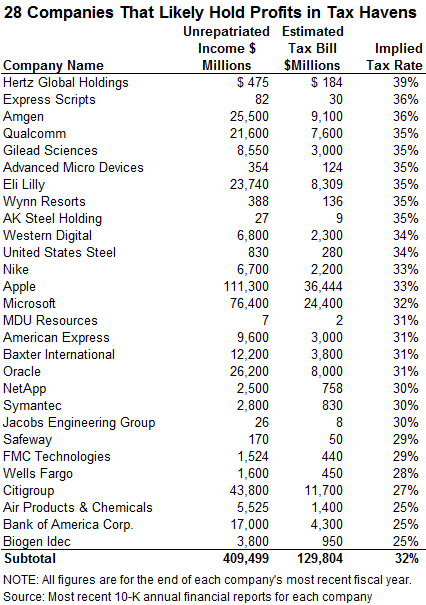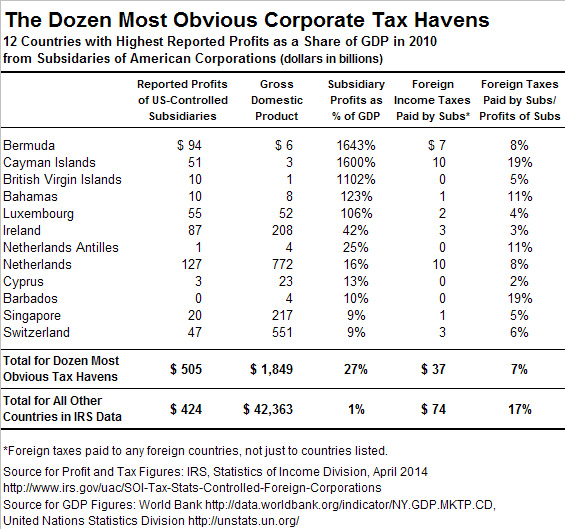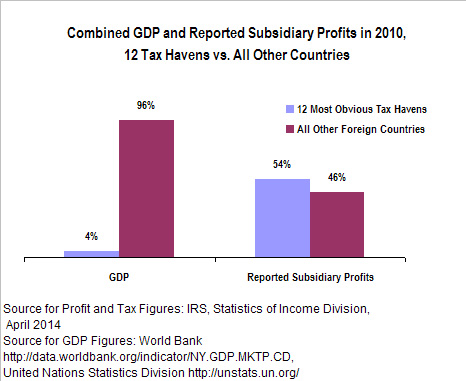May 19, 2014 01:04 PM | Permalink | 
Hundreds More Likely Do the Same, Avoiding $550 Billion in U.S. Taxes
Read this report in PDF (Includes Company by Company Appendixies)
Download the Company by Company PRE Data (XLS)

American Fortune 500 corporations are likely saving about $550 billion by holding nearly $2 trillion of “permanently reinvested” profits offshore. Twenty-eight of these corporations reveal that they have paid an income tax rate of 10 percent or less to the governments of the countries where these profits are officially held, indicating that most of these profits are likely in offshore tax havens.
While congressional hearings over the past few years have focused attention on the tax avoidance strategies of technology corporations like Apple and Microsoft, this report shows that a diverse array of companies are using offshore tax havens, including U.S. Steel, the pharmaceutical giant Eli Lilly, the apparel manufacturer Nike, the supermarket chain Safeway, the financial firm American Express, and banking giants Bank of America and Wells Fargo.
How We Know When Multinationals’ Offshore Cash is Largely in Tax Havens
Some American multinational corporations complain to members of Congress that their offshore profits would be taxed at the U.S. corporate income tax rate of 35 percent if those profits were subject to U.S. taxes. However, this can only be true if those profits are mostly held in tax havens — countries in which they are subject to little or no corporate tax.
The general rule is that offshore profits that an American corporation “repatriates” (officially brings back to the United States) are subject to the U.S. tax rate of 35 percent minus a tax credit equal to whatever taxes were paid to foreign governments. Thus, if an American corporation says it would pay a U.S. tax rate of 25 percent or more on its offshore profits, that means it has paid foreign governments a tax rate of 10 percent or less.
Twenty-eight American corporations have acknowledged paying less than a 10 percent foreign tax rate on the $409 billion they collectively hold offshore. The table on the following page shows the disclosures made by these 28 corporations in their most recent annual financial reports.
It is almost always the case that profits reported by corporations to the IRS as earned in tax havens were actually earned in the United States or another country with a tax system similar to ours. Most economically developed countries (most of the countries where there are real business opportunities for American corporations) have a corporate income tax rate of at least 20 percent and rates are typically higher than that. The countries that have no corporate income tax or a very low corporate tax — countries like Bermuda, the Cayman Islands, and the Bahamas — provide very little in the way of real business opportunities for American corporations like U.S. Steel, Safeway, and Microsoft. But large Americans corporations use accounting gimmicks (most of which are, unfortunately, allowed under current law) to make profits appear to be earned in tax haven countries.
Hundreds of Other Fortune 500 Corporations Don’t Disclose This Information
These 28 companies are not alone in shifting their profits to low-tax havens—they’re only alone in disclosing it. A total of 301 Fortune 500 corporations have disclosed, in their most recent financial reports, holding some of their income as “permanently reinvested” offshore profits. At the end of 2013, these permanently reinvested earnings totaled a whopping $1.95 trillion. (A full list of these 301 corporations is published as an appendix to this paper.) Yet the vast majority of these companies — 243 out of 301 —decline to disclose the U.S. tax rate they would pay if these offshore profits were repatriated. (58 corporations, including the 28 companies shown on this page, disclose this information. A full list of the 58 companies is published as an appendix to this paper.) The non-disclosing companies collectively hold $1.4 trillion in unrepatriated offshore profits at the end of 2013.
Accounting standards require publicly held companies to disclose the U.S. tax they would pay upon repatriation of their offshore profits — but these standards also provide a loophole allowing companies to assert that calculating this tax liability is “not practicable.” Almost all of the 243 non-disclosing companies use this loophole to avoid disclosing their likely tax rates upon repatriation — even though these companies almost certainly have the capacity to estimate these liabilities.
20 of the Biggest “Non-Disclosing” Companies Hold $801 Billion Offshore
 While hundreds of companies refuse to disclose the tax they likely owe on their offshore cash, just a handful of these companies account for the lion’s share of the permanently reinvested foreign profits in the Fortune 500. The nearby table shows the 20 non-disclosing companies with the biggest offshore stash at the end of the most recent fiscal year. These 20 companies held $801 billion in unrepatriated offshore income — more than half of the total income held by the 243 “non-disclosing” companies. Most of these companies also disclose, elsewhere in their financial reports, owning subsidiaries in known tax havens. For example:
While hundreds of companies refuse to disclose the tax they likely owe on their offshore cash, just a handful of these companies account for the lion’s share of the permanently reinvested foreign profits in the Fortune 500. The nearby table shows the 20 non-disclosing companies with the biggest offshore stash at the end of the most recent fiscal year. These 20 companies held $801 billion in unrepatriated offshore income — more than half of the total income held by the 243 “non-disclosing” companies. Most of these companies also disclose, elsewhere in their financial reports, owning subsidiaries in known tax havens. For example:
■ General Electric disclosed holding $110 billion offshore at the end of 2013. GE has subsidiaries in the Bahamas, Bermuda, Ireland and Singapore, but won’t disclose how much of its offshore cash is in these low-tax destinations. [Some of it is clearly there; see text box below.]
■ Pfizer has subsidiaries in Bermuda, the Cayman Islands, Ireland, the Isle of Jersey, Luxembourg and Singapore, but does not disclose how much of its $69 billion in offshore profits are stashed in these tax havens.
■ Merck has12 subsidiaries in Bermuda alone. It’s unclear how much of its $57 billion in offshore profits are being stored (for tax purposes) in this tiny island.
Even “Non-Disclosers” Slip Up SometimesAs noted above, General Electric does not disclose the U.S. tax it would owe if its $110 billion offshore stash was repatriated. But in its 2009 annual report, GE noted that it had reclassified $2 billion of previously earned foreign profits as “permanently reinvested” offshore, and said that this change resulted “in an income tax benefit of $700 million.” Since $700 million is 35 percent of $2 billion, this is an admission that the expected foreign tax rate on this $2 billion of offshore cash was exactly zero, which in turn strongly suggests that GE’s “permanent reinvestment” plan for this $2 billion involved assigning it to one of its tax haven subsidiaries.
Even “Non-Disclosers” Slip Up Sometimes
As noted above, General Electric does not disclose the U.S. tax it would owe if its $110 billion offshore stash was repatriated. But in its 2009 annual report, GE noted that it had reclassified $2 billion of previously earned foreign profits as “permanently reinvested” offshore, and said that this change resulted “in an income tax benefit of $700 million.” Since $700 million is 35 percent of $2 billion, this is an admission that the expected foreign tax rate on this $2 billion of offshore cash was exactly zero, which in turn strongly suggests that GE’s “permanent reinvestment” plan for this $2 billion involved assigning it to one of its tax haven subsidiaries.
Time is of the Essence
While the $2 trillion in offshore profits detailed in the appendix has grown gradually over the past decade, there are two reasons why it is vital that Congress act promptly to deal with this problem. First, a large number of the biggest corporations appear to be increasing their offshore cash significantly. 105 of the companies surveyed in this report increased their declared offshore cash by at least $500 million each in the last year alone. Eight particularly aggressive companies each increased their permanently reinvested foreign earnings by more than $5 billion in the past year. These include Apple, Microsoft, IBM, Google, and Cisco.
A second reason for concern is that there is some evidence companies are aggressively seeking to permanently shelter their offshore cash from U.S. taxation by engaging in corporate inversions, through which companies acquire smaller foreign companies and reincorporate in foreign countries, thus avoiding most or all U.S. tax on their profits. Drug giant Pfizer is currently attempting this move.
Hundreds of Billions in Tax Revenue at Stake
It’s impossible to know precisely how much income tax would be paid, under current tax rates, upon repatriation by the 243 Fortune 500 companies that have disclosed holding profits overseas but have failed to disclose how much U.S. tax would be due if the profits were repatriated. But if these companies paid the same 28 percent average tax rate as the 58 disclosing companies, the resulting one-time tax would total $403 billion for these 243 companies. Added to the $148 billion tax bill estimated by the 58 companies who did disclose, this means that taxing all “permanently reinvested” foreign income of the 301 companies at the current federal tax rate could result in more than $550 billion in added corporate tax revenue.
What Should Be Done?
Many large multinationals that fail to disclose whether their offshore profits are officially in tax havens are the same companies that have lobbied heavily for tax breaks on their offshore cash. These companies propose either to enact a temporary “tax holiday” for repatriation, under which companies officially bringing offshore profits back to the U.S. would pay a very low tax rate on the repatriated income, or a permanent exemption for offshore income in the form of a “territorial” tax system. Either of these proposals would actually increase the incentive for multinationals to shift their U.S. profits, on paper, into tax havens.
A far more sensible solution would be to simply end “deferral,” that is, repealing the rule that indefinitely exempts offshore profits from U.S. income tax until these profits are repatriated. Ending deferral would mean that all profits of U.S. corporations, whether they are generated in the U.S. or abroad, would be taxed by the United States in the year they are earned. Of course, American corporations would continue to receive a “foreign tax credit” against any taxes they pay to foreign governments, to ensure profits are not double-taxed.
Conclusion
The limited disclosures made by Apple and a handful of other Fortune 500 corporations show that they have moved profits into tax havens — and that some have managed to avoid virtually all taxes on these profits. But the scope of this tax avoidance is likely much larger, since the vast majority of Fortune 500 companies with offshore cash refuse to disclose how much tax they would pay on repatriating their offshore profits.
Lawmakers should resist calls for tax changes, such as repatriation holidays or a territorial tax system, that would reward U.S. companies for shifting their profits to tax havens. If the Securities and Exchange Commission required more complete disclosure about multinationals’ offshore profits, it would become obvious that Congress should end deferral, thereby eliminating the incentive for multinationals to shift their profits offshore once and for all.
 Republicans on the House Ways and Means Committee voted today to make permanent “bonus” depreciation, the most costly provision within the “tax extenders.” Bonus depreciation is a significant expansion of existing breaks for business investment. The Congressional Research Service has reviewed quantitative analyses of the tax break and found that, “… accelerated depreciation in general is a relatively ineffective tool for stimulating the economy.”
Republicans on the House Ways and Means Committee voted today to make permanent “bonus” depreciation, the most costly provision within the “tax extenders.” Bonus depreciation is a significant expansion of existing breaks for business investment. The Congressional Research Service has reviewed quantitative analyses of the tax break and found that, “… accelerated depreciation in general is a relatively ineffective tool for stimulating the economy.” Since Ohio Governor John Kasich ran for office on a promise to gradually eliminate the state income tax, tax cuts have been almost constantly on the agenda in the Buckeye state. Last week, the state Senate advanced a $400 million tax cut plan that would accelerate already-scheduled income tax rate reductions and increase an existing tax break for “pass through” businesses, while providing much smaller tax breaks to low- and middle-income families. The plan next goes to a joint House-Senate conference committee.
Since Ohio Governor John Kasich ran for office on a promise to gradually eliminate the state income tax, tax cuts have been almost constantly on the agenda in the Buckeye state. Last week, the state Senate advanced a $400 million tax cut plan that would accelerate already-scheduled income tax rate reductions and increase an existing tax break for “pass through” businesses, while providing much smaller tax breaks to low- and middle-income families. The plan next goes to a joint House-Senate conference committee. There’s been an
There’s been an 






 The summer driving season is kicking off this weekend, so our colleagues at the Institute on Taxation and Economic Policy (ITEP) have released
The summer driving season is kicking off this weekend, so our colleagues at the Institute on Taxation and Economic Policy (ITEP) have released 

 While hundreds of companies refuse to disclose the tax they likely owe on their offshore cash, just a handful of these companies account for the lion’s share of the permanently reinvested foreign profits in the Fortune 500. The nearby table shows the 20 non-disclosing companies with the biggest offshore stash at the end of the most recent fiscal year. These 20 companies held $801 billion in unrepatriated offshore income — more than half of the total income held by the 243 “non-disclosing” companies. Most of these companies also disclose, elsewhere in their financial reports, owning subsidiaries in known tax havens. For example:
While hundreds of companies refuse to disclose the tax they likely owe on their offshore cash, just a handful of these companies account for the lion’s share of the permanently reinvested foreign profits in the Fortune 500. The nearby table shows the 20 non-disclosing companies with the biggest offshore stash at the end of the most recent fiscal year. These 20 companies held $801 billion in unrepatriated offshore income — more than half of the total income held by the 243 “non-disclosing” companies. Most of these companies also disclose, elsewhere in their financial reports, owning subsidiaries in known tax havens. For example: